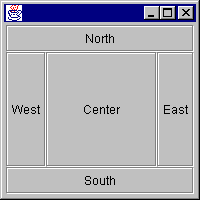|
||||||||||
| PREV CLASS NEXT CLASS | FRAMES NO FRAMES | |||||||||
| SUMMARY: INNER | FIELD | CONSTR | METHOD | DETAIL: FIELD | CONSTR | METHOD | |||||||||
java.lang.Object | +--org.zaval.lw.LwBorderLayout
The class implements layout manager interface. The layout divides container area
into five parts: North, South, East,
West, and Center. To add a component to a container
with the border layout, use one of constants of this layout manager as the constraints,
for example:
...
LwContainer c = new LwPanel();
c.setLwLayout(new LwBorderLayout());
c.add(LwBorderLayout.SOUTH, new LwButton("South"));
...
The image below shows how the five buttons have been laid out with the border layout
manager inside the container: 
| Field Summary | |
static java.lang.Object |
CENTER
The center layout constraint (middle of container). |
static java.lang.Object |
EAST
The east layout constraint (left side of container). |
static java.lang.Object |
NORTH
The north layout constraint (top of container). |
static java.lang.Object |
SOUTH
The south layout constraint (bottom of container). |
static java.lang.Object |
WEST
The west layout constraint (right side of container). |
| Constructor Summary | |
LwBorderLayout()
Constructs a new border layout with no gaps between components. |
|
LwBorderLayout(int hgap,
int vgap)
Constructs a border layout with the specified gaps between components. |
|
| Method Summary | |
java.awt.Dimension |
calcPreferredSize(LayoutContainer target)
Calculates the preferred size dimension for the layout container. |
void |
componentAdded(java.lang.Object id,
Layoutable comp,
int index)
Invoked when the specified layoutable component is added to the layout container, that uses the layout manager. |
void |
componentRemoved(Layoutable lw,
int index)
Invoked when the specified layoutable component is removed from the layout container, that uses the layout manager. |
int |
getHgap()
Returns the horizontal. |
int |
getVgap()
Returns the vertical gap. |
protected static boolean |
isVisible(Layoutable l)
Tests if the specified layout container is not null and visible. |
void |
layout(LayoutContainer target)
Lays out the child layoutable components inside the specified layout container. |
void |
setHgap(int hgap)
Sets the horizontal gap. |
void |
setVgap(int vgap)
Sets the vertical gap. |
| Methods inherited from class java.lang.Object |
clone, equals, finalize, getClass, hashCode, notify, notifyAll, toString, wait, wait, wait |
| Field Detail |
public static final java.lang.Object NORTH
public static final java.lang.Object SOUTH
public static final java.lang.Object EAST
public static final java.lang.Object WEST
public static final java.lang.Object CENTER
| Constructor Detail |
public LwBorderLayout()
public LwBorderLayout(int hgap,
int vgap)
hgap and the vertical gap is
specified by vgap.hgapvgap| Method Detail |
public int getHgap()
public void setHgap(int hgap)
hgappublic int getVgap()
public void setVgap(int vgap)
vgap
public void componentAdded(java.lang.Object id,
Layoutable comp,
int index)
componentAdded in interface LwLayoutidcompindex
public void componentRemoved(Layoutable lw,
int index)
componentRemoved in interface LwLayoutlwindexpublic java.awt.Dimension calcPreferredSize(LayoutContainer target)
calcPreferredSize in interface LwLayouttargetpublic void layout(LayoutContainer target)
layout in interface LwLayouttargetprotected static boolean isVisible(Layoutable l)
null and visible.ltrue if the layoutable component is not null and visible;
otherwise false
|
||||||||||
| PREV CLASS NEXT CLASS | FRAMES NO FRAMES | |||||||||
| SUMMARY: INNER | FIELD | CONSTR | METHOD | DETAIL: FIELD | CONSTR | METHOD | |||||||||